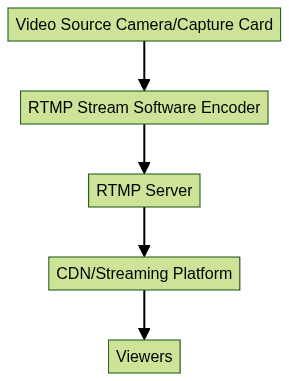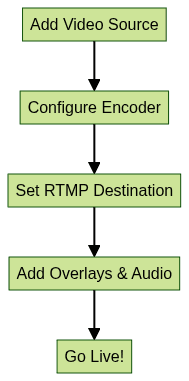Introduction to RTMP Stream Software
RTMP stream software has become a cornerstone of modern live streaming workflows. RTMP, or Real-Time Messaging Protocol, enables the seamless transmission of video, audio, and data across networks, making it the backbone of live video production and delivery. RTMP stream software refers to applications that encode, transmit, and receive live streams using the RTMP protocol.
With the explosion of live streaming across platforms like YouTube, Facebook, and Twitch, robust RTMP software is more critical than ever. These tools have evolved to support multi-platform streaming, real-time analytics, adaptive transcoding, and integration with other modern streaming protocols like SRT and HLS. In 2025, RTMP remains highly relevant for low-latency streaming, contributing to reliable broadcast-quality experiences for content creators, broadcasters, and enterprises alike.
How RTMP Stream Software Works
The RTMP protocol, originally developed by Macromedia (now Adobe), is designed for high-performance transmission of audio, video, and data between a server and client. RTMP stream software acts as either a client (pushing streams) or a server (receiving and redistributing streams). Typically, the workflow involves capturing video/audio, encoding it in real-time, and pushing the stream to an RTMP server, which then delivers it to viewers or other platforms.
RTMP fits into the streaming pipeline as the transport layer before adaptive streaming protocols like HLS or DASH handle delivery to end-users. Its persistent connections and low latency make it ideal for live broadcast scenarios, though it is often paired with other protocols for broader device compatibility. For developers looking to build custom live streaming solutions, integrating a
Live Streaming API SDK
can streamline the process and enable advanced interactive features.
Key Features to Look For in RTMP Stream Software
When evaluating RTMP stream software in 2025, key features should include:
- Multi-source input: Support for cameras, files, network streams, and NDI sources for flexible video production.
- Encoding/transcoding: Real-time encoding in formats like H.264, HEVC, and AAC, with GPU acceleration for efficiency.
- Multi-platform streaming: Built-in support for streaming to YouTube, Facebook, Twitch, and custom RTMP servers.
- Audio mixing, overlays, and titling: Integrated tools for audio routing, mixing, lower thirds, and branded graphics overlays.
- Recording, monitoring, analytics: The ability to record streams locally, monitor performance metrics, and access real-time analytics for stream health and engagement.
Advanced RTMP stream software also offers plugin support, scripting, API integration, bandwidth management, and security features (stream keys, access controls) to meet diverse production requirements. If your workflow requires real-time communication, consider solutions with a
Video Calling API
to enable seamless video conferencing alongside your live streams.Top RTMP Stream Software Solutions
OBS Studio (Open Broadcaster Software)
OBS Studio remains the most popular open-source RTMP stream software in 2025, prized for its cross-platform compatibility (Windows, macOS, Linux) and extensive community support. OBS enables complex scene composition, transitions, and multi-source input, making it ideal for both newcomers and professionals.
Key features include robust plugin architecture, advanced audio mixing, real-time chroma keying, and GPU-accelerated encoding. OBS is highly customizable, with scripting support (Python, Lua) and integrations for streaming destinations, overlays, and analytics. For those building custom streaming or conferencing applications, integrating a
Live Streaming API SDK
can further expand OBS’s capabilities and automation potential.Basic RTMP Configuration in OBS
1{
2 "stream": {
3 "service": "Custom...",
4 "server": "rtmp://your-rtmp-server/live",
5 "key": "your-stream-key"
6 }
7}
8vMix
vMix is a professional-grade RTMP stream software known for its powerful production tools, including instant replay, multi-view, and advanced switching. vMix supports a vast array of video sources (SDI, NDI, capture cards), real-time titling, and integrated audio mixing.
With native RTMP, SRT, and HLS output, vMix makes it easy to stream to multiple platforms simultaneously. It features GPU-accelerated encoding, recording, and virtual sets for broadcast-quality visuals. Licensing options range from free trials to advanced editions with 4K and multi-channel support, catering to studios, churches, and enterprises. If you’re interested in adding real-time communication to your production, vMix can be complemented by a
Video Calling API
for integrated guest interviews and remote contributions.Wowza Streaming Engine
Wowza Streaming Engine is an enterprise-grade RTMP server and streaming software, built for reliability and scale. It supports cloud and on-premises deployment, with robust APIs for integration and automation. Wowza enables adaptive bitrate streaming, live-to-VOD workflows, and dynamic transcoding.
Key features include support for all major protocols (RTMP, SRT, HLS, DASH), advanced security controls, and real-time analytics. Wowza is ideal for organizations needing high-availability, multi-protocol delivery, and custom workflow automation. For developers seeking alternatives to traditional solutions, exploring a
jitsi alternative
can offer new possibilities for scalable, secure video communication within your streaming infrastructure.Restreamer (datarhei)
Restreamer is a lightweight, open-source RTMP stream software designed for easy deployment via Docker. It simplifies multi-streaming to multiple destinations, supports bandwidth management, and offers a web-based UI for configuration.
Restreamer is well-suited for self-hosted projects, IP camera streaming, and bandwidth-conscious environments where efficient RTMP relay is critical. If you’re developing mobile streaming apps, learning about
webrtc android
can help you implement low-latency, browser-based video streaming on Android devices.Streambuilder.pro
Streambuilder.pro delivers advanced transcoding, GPU-accelerated encoding, and multi-platform streaming. It's designed for high-performance workflows, supporting both live and VOD applications with API integration and automated stream management. Developers working with cross-platform apps may also benefit from exploring
flutter webrtc
to enable real-time video streaming in Flutter-based projects.Happytime RTMP Client/Server
Happytime RTMP provides a lightweight, easy-to-deploy client/server solution for RTMP push and pull streaming. It supports multi-streaming and can be integrated into custom applications or used as a standalone relay. For those building web-based video chat or broadcast apps, check out
react video call
guides to quickly implement video calling features in React applications.Setting Up Your First RTMP Live Stream
Setting up an RTMP live stream in 2025 involves several key steps:
- Choose your RTMP stream software: Select a solution (e.g., OBS Studio, vMix, Restreamer) based on your platform, feature needs, and licensing preferences.
- Configure video/audio sources: Connect cameras, capture cards, files, or network streams as sources within your chosen software.
- Set up encoding/transcoding: Choose an appropriate codec (H.264 for compatibility, HEVC for efficiency) and adjust bitrate, resolution, and audio settings as needed.
- Define your streaming destination: Enter your RTMP server URL and stream key, or select from built-in platform integrations for YouTube, Facebook, or Twitch.
- Add overlays and audio mixing: Integrate graphics, lower thirds, and mix audio channels for a professional look.
- Monitor and start streaming: Use built-in monitoring tools to check stream health, latency, and bandwidth usage.
If you want to add interactive features or real-time communication to your live stream, integrating a
Video Calling API
can enhance audience engagement and collaboration.Sample RTMP URL/Config
1rtmp://your-rtmp-server/live/your-stream-key
2
Advanced Tips for Reliable RTMP Streaming
To ensure a smooth and reliable RTMP streaming experience:
- Optimize encoding settings: Use variable bitrate (VBR) for fluctuating network conditions. Choose resolutions and bitrates appropriate for your audience and available bandwidth.
- Use SRT as a fallback: Implement SRT (Secure Reliable Transport) alongside RTMP for resilient, low-latency backup streaming, especially over unreliable networks.
- Leverage hardware acceleration: Enable GPU encoding (NVENC, Quick Sync, or AMD VCE) to reduce CPU load and improve encoding efficiency.
- Monitor analytics: Use real-time analytics and monitoring tools to detect dropped frames, buffer events, and bandwidth spikes.
- Secure your stream: Protect RTMP endpoints with unique stream keys and access controls to prevent unauthorized access and stream hijacking.
For those interested in experimenting with professional-grade streaming tools, you can
Try it for free
and explore advanced features before committing to a paid plan.RTMP vs. Other Streaming Protocols
While RTMP remains popular for ingest due to its low latency and broad compatibility, other protocols are increasingly used for delivery:
- SRT: Offers reliable, encrypted, and low-latency streaming, especially for point-to-point or remote production.
- HLS: HTTP Live Streaming is widely supported and ideal for adaptive bitrate delivery to a broad range of devices, but introduces higher latency.
- DASH: Similar to HLS, but with more flexibility for advanced streaming scenarios and adaptive media.
RTMP excels for contribution and live production, while HLS and DASH dominate for viewer delivery. Many RTMP stream software solutions now support hybrid workflows, combining the strengths of each protocol.
Conclusion: Choosing the Best RTMP Stream Software for Your Needs
Selecting the right RTMP stream software depends on your workflow, technical requirements, and budget. OBS Studio is ideal for open-source, community-driven streaming; vMix excels for professional production; Wowza serves enterprise needs; and lightweight tools like Restreamer and Happytime RTMP fit self-hosted or simple relay scenarios. Evaluate features such as protocol support, encoding options, analytics, and ease of use to match your live streaming ambitions in 2025.
Want to level-up your learning? Subscribe now
Subscribe to our newsletter for more tech based insights
FAQ